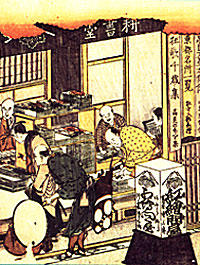|
This course is centered on urban popular culture, particularly
that of Edo (present-day Tokyo) from the early 17th to the late 19th
century. While there is a list of content that we will cover— woodblock prints, kabuki theater, pleasure
quarters, street gangs, commoner carnivals, popular literature
and so on—we will not limit our investigations to the mere enumeration
and chronological layout of a certain content that might be labeled “popular
culture in early modern Japan.” We will be just as concerned
with the form and the concept of “popular culture” in early
modern Japan as we are the content.
One question that
will engage us is the degree to which formations of popular culture
serve to liberate or control everyday lives. Another
is how popular cultural practices have served to construct, reinforce,
and contest gender, status, and ethnic identities. There is a practically
unlimited supply of items that we might include in our investigation;
unfortunately we do not have unlimited time in pursuing them. Thus,
I have made strategic choices in organizing our material. For the
most part I have chosen topics according to a couple of considerations:
first, availability of English-language materials for readings; second,
connections that can be drawn among topics. After that, it’s
my own personal fashion decision.
|
 |


